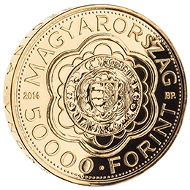July 24, 2014 – With the issue of Queen Mary’s gold florin, the Magyar Nemzeti Bank continues its series “Medieval Hungarian Gold Florins”, launched with the gold florins of Charles I in 2012 and Louis I in 2013. For the first time in the history of issuing forint collector coins, the Magyar Nemzeti Bank is also issuing a non-ferrous metal version of the gold commemorative coin, with the same pattern, but a nominal value of HUF 2,000.
Hungary/ 50,000 HUF/ Silver .986/ 20mm/ Designer: Soltra E. Tamas.
Smooth edge: 3.491 g/ Mintage: 2,000. Edge lettering: 13.964 g/ Mintage: 500.))
The front of the coin depicts the obverse of Queen Mary’s gold florin with a field of six stripes in a rosette and was designed by sculptor E. Tamás Soltra. A figure of Saint Ladislaus holding an axe is found on the back, along with a cross in a circle mint mark which was used exclusively on the coins minted under Queen Mary’s reign. The piefort version has the edge inscription +MARIA•DEI•GRATIA•REGINA•VNGARIE (Mary, by the Grace of God, Queen of Hungary).
Mary, Queen of Hungary, was born the daughter of King Louis I and Elizabeth Kotromanic of Bosnia in 1371. One week after the death of King Louis on 10 September 1382, Mary was crowned Queen of Hungary in Székesfehérvár, but her mother assumed the regency for the 11-year old child. In August of 1385, Mary was betrothed to Sigismund, but her mother wished to keep power and successfully prevented Sigismund from taking the throne for some time. Elizabeth was only supported by some of the barons, and pressured by the opposing faction she had to accept the coronation of Charles Durazzoi (the Short) as King Charles II of Hungary on 31 December 1385.
Hungary/ 2,000 HUF/ 2.7 g/ 20mm/ Mintage: 5,000.
The queen, however, arranged to have Charles II assassinated by Balázs Forgách on 7 February 1386 at the Castle of Buda (Charles died of his wounds on 24 February in Visegrád). After his death, Mary was nominally ruler again, but in practice the country was run by Elizabeth and her main supporter, Palatine Nicholas I Garai. In 1386, the queen and her mother were attacked while travelling in Croatian territory and captured, and Elizabeth was strangled in front of her daughter’s eyes. Mary was only released from captivity after the coronation of Sigismund as King of Hungary on 31 March 1387. She did not participate in ruling the country then either, as her husband ran the affairs of state. On 17 May 1395, the pregnant Queen died as the result of falling from her horse while hunting. She was buried in Nagyvárad (now Oradea, Romania) next to the tomb of Saint Ladislaus.
Queen Mary had gold florins, silver denars and obol coins minted during her short reign. Her gold florins were a direct successor to those minted by her father, featuring the Hungarian arms and those of the house of Anjou on the front and a standing figure of Saint Ladislaus on the back. Mint marks on the gold coins were not known earlier and so far it has not been possible to determine where the coins were minted. Logically speaking, the most important mints might have been involved, such as Buda or Körmöcbánya (present-day Kremnica, Slovakia) or the mint in Transylvania, where gold coins had previously been minted. There is similar uncertainty about when Queen Mary’s minting of coins came to an end: did it end in 1387 when Sigismund ascended the throne, or did it continue until her death in 1395?
This CoinsWeekly article reported on the first gold florin in the series, depicting Charles I, in 2012.
You can of course also visit the Hungarian Mint online.








